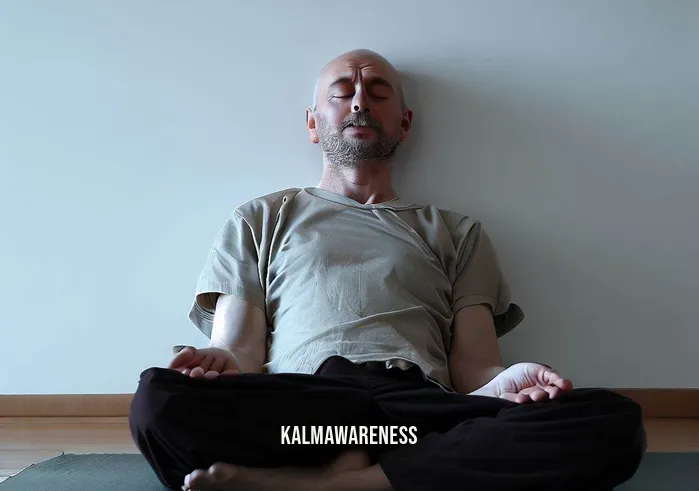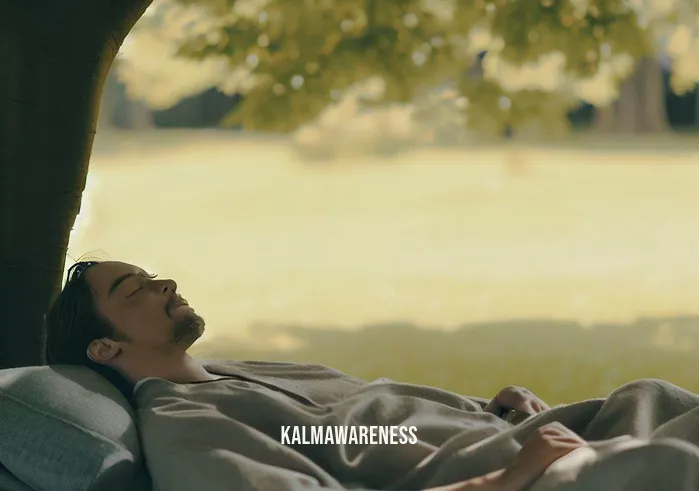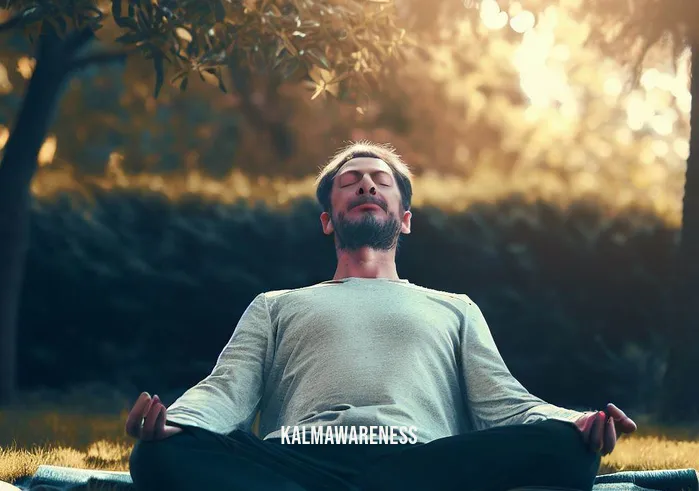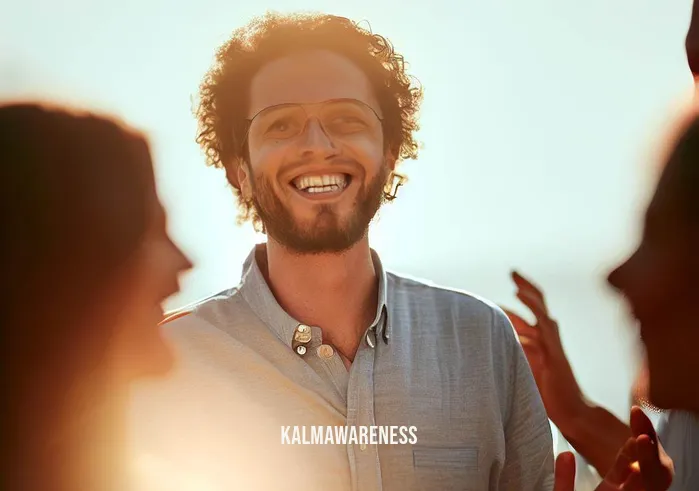Can I Meditate Laying Down? Exploring Horizontal Meditation for Ultimate Relaxation
The Common Misconceptions Surrounding Lying Down Meditation
The question, “Can I meditate laying down?” often evokes polarized opinions among seasoned practitioners and newcomers alike. Traditional meditation techniques place an immense emphasis on the quintessential seated pose: an upright back, a certain mudra, and an intense focus on the breath. But sometimes, this image feeds into a misconception that may deter people from exploring meditation as a practice. Some individuals find sitting for extended periods uncomfortable or even painful due to physical limitations or health conditions. For these people, the very act of sitting down to meditate might induce stress rather than alleviate it.
Horizontal Meditation: A Shift in Perspective
Horizontal or lying down meditation offers a valid alternative to the more traditional seated posture. It caters to those who find it challenging to maintain a seated position, offering the possibility of enhanced relaxation and mindfulness. If done mindfully, this posture allows for a deeper sense of physical ease, encouraging a smooth transition into the meditative state. This is especially important for those who suffer from physical discomfort or those who are looking to practice meditation right before sleep. Aspects like mindful movement during sleep are more compatible with this posture and often yield more effective results.
How Lying Down Meditation Contributes to Relaxation
- Physical Comfort: Lying down can alleviate physical strain, making it easier to focus on one’s inner experience.
- Ease of Practice: Horizontal meditation is more approachable for beginners who may be intimidated by traditional meditation practices.
- Enhanced Mindfulness: Reclining naturally puts the body into a state of relaxation, which can facilitate a peaceful state of mind.
“As you recline, let go of the tensions, the bustling thoughts, and the hustle of the day. This is your time.“
— Jack Kornfield
Combining Horizontal Meditation with Other Techniques
Horizontal meditation does not have to be a standalone practice. It can be combined with various other techniques to enhance its effectiveness. For instance, you could incorporate aspects of EMDR meditation to help with trauma healing while laying down. Breathing exercises, one of the essential elements of some meditation exercises, can also be performed more naturally when lying down, making it easier to concentrate on your breath.
Breaking the Stigma
People often ask, “Can lying down during meditation lead to sleep?” While it’s true that the reclining posture is associated with rest and sleep, proper technique can ensure that you remain alert and conscious during your practice. Remember, the goal of meditation is not just to stabilize your thoughts, but also to attain a state of mindful relaxation. If sleep does come, perhaps that’s what your body needs at that moment.
As you explore the possibilities of horizontal meditation, keep in mind that the primary purpose of meditation is to facilitate inner peace, enhance mindfulness, and nurture self-care in a sustainable way. Contrary to common belief, lying down while meditating could be your pathway to achieving just that.
To gain a deeper understanding of how lying down meditation can be adapted to various life stages, special conditions, and daily routines, continue reading as we delve into its applications for teenagers, during pregnancy, and for quick power naps in the next chapter.

Reclining Into Mindfulness: Advantages and Techniques of Meditating While Lying Down
Why the Question “Can I Meditate Laying Down?” Matters
The question “Can I meditate laying down?” isn’t trivial; it’s a matter of accessibility, comfort, and personal preference in a world full of diversity. If meditation can adapt to meet individual needs, it increases the likelihood that more people will incorporate this practice into their lives. From busy professionals in need of a 15-minute power nap to teenagers whose lives are in constant flux, making meditation versatile is vital. Let’s explore the particular circumstances where reclining meditation shines.
Ideal Scenarios for Lying Down Meditation
During Pregnancy: Lying down can offer relief and focus during the journey of pregnancy. Techniques such as mindful hypnobirthing pair well with a reclined position.
For Teenagers: For those in their formative years dealing with academic pressure and social complexities, lying down meditation can be easily integrated into their daily routine. It can be a method to promote healthy walking and activity habits by serving as a calming precursor or follow-up.
Quick Power Naps: For people with taxing schedules who still need to keep their minds sharp, a reclining position allows for effective short meditation sessions or power naps.
Physical Discomfort: For individuals who experience physical pain when sitting for long periods, lying down provides an alternative that can be both comforting and meditative.
Pre-Sleep Ritual: Lying down meditation can serve as an excellent technique for those struggling with sleep, aiding the transition from a state of wakefulness to restful sleep.
| Scenario | Benefits of Lying Down Meditation | Recommended Techniques |
|---|---|---|
| During Pregnancy | Physical relief, mental focus | Mindful Hypnobirthing |
| For Teenagers | Ease of integration, reduced stress | Mindful Movement, Rouse Yoga |
| Quick Power Naps | Refreshed mind, restored energy | Deep Breathing, 256 Hz Sound Meditation |
| Physical Discomfort | Reduced pain, better focus | Body Scan, Touch That Body Part |
| Pre-Sleep Ritual | Easier transition to sleep | Mindful Movement Sleep, Deep Breathing |
Sustainable Self-Care Through Reclining Meditation
The ultimate goal of any meditation practice should be sustainable self-care. Just as one wouldn’t stick to a diet that’s too rigid or an exercise routine that’s too strenuous, meditation should adapt to fit the individual, not the other way around. Reclining meditation offers that flexibility, and it is this adaptability that turns meditation from a sometimes-practice to a sustainable habit.
“Flexibility in approach allows for sustainability in practice.”
— The Judgement of the Wise
Summing it Up: The Versatility of Lying Down Meditation
Meditating while lying down isn’t a one-size-fits-all remedy, but it is a valuable addition to your mindfulness toolkit. Whether you’re a teenager trying to find your footing or someone navigating the complexities of pregnancy, this posture offers a versatile and comfortable approach to attaining a peaceful state of mind.
As you venture further into the realm of reclining meditation, it’s crucial to remember that the most effective meditation practice is one that you can realistically incorporate into your daily life. With this thought, we will delve into the specifics of combining lying down meditation with various life stages and circumstances in the next chapter. There, we will also look into how the practice complements other forms of physical activity and mental exercises. Continue reading to enrich your understanding even further.

The Transformative Power of Horizontal Meditation: Finding Hope and Inspiration Through Stillness
Reimagining Meditation: The Concept of Horizontal Meditation
In the popular imagination, the act of meditation often conjures images of seated silence, closed eyes, and folded hands. However, the practice of lying down—or horizontal meditation—introduces an alternative that allows for greater flexibility and inclusion. When asking, “Can I meditate laying down?”, you’re not just seeking comfort. You’re challenging the status quo of mindfulness, seeking a simplified approach to meditation that aligns with your unique lifestyle.
“Don’t adapt to the energy in the room. Influence the energy in the room.”
— Anonymous
Inspirational Perspectives on Lying Down Meditation
The Therapeutic Aspect: Lying down can help make therapeutic techniques like EMDR meditation more comfortable and effective. When you’re horizontal, your body is at its most relaxed, allowing you to more freely explore your mental and emotional landscape.
“Calm mind brings inner strength and self-confidence, so that’s very important for good health.”
— Dalai LamaBalancing Mind and Body: Jack Kornfield, a well-known mindfulness teacher, has emphasized the importance of incorporating various postures into meditation practice. Lying down meditation fits well into this philosophy, complementing other activities like yoga.
“In sitting meditation, we train in mindfulness and compassion for one moment at a time.”
— Jack KornfieldMindfulness for All: Horizontal meditation shatters the notion that meditation is confined to particular postures or populations. It’s an inclusive practice that welcomes everyone—from beginners to advanced practitioners. Whether you’re a restless teenager seeking mindful activities or someone seeking stability, the horizontal posture provides an open door.
“The present moment is filled with joy and happiness. If you are attentive, you will see it.”
— Thich Nhat HanhThe Power of Daily Ritual: The idea of dedicating a moment of mindfulness each day can seem daunting. Horizontal meditation simplifies this by enabling people to meditate in the very space where they start and end their days—their beds or any comfortable lying surface.
“Meditation is not about stopping thoughts, but recognizing that we are more than our thoughts and our feelings.”
— Arianna Huffington
Implications of Horizontal Meditation: Beyond Relaxation
While lying down meditation is often associated with relaxation and rest, it serves as a powerful tool for mental transformation. As you lie down to meditate, you’re not just entering a state of relaxation but embarking on a transformative journey. You can target specific areas of life improvement, from how to stabilize emotions to cultivating a life of mindfulness and peace.
A Look Ahead: Where Horizontal Meditation Takes Us
Horizontal meditation is more than an alternative to the traditional seated practice. It is an innovative way to approach mindfulness, making it accessible, flexible, and inclusive. As you bring this lying down practice into your daily life, you open up a world of possibilities in mental well-being and self-care.
Next, we will delve into the scientific backing and evidence that supports lying down meditation as an effective practice. From neurological benefits to impacts on physical health, prepare to be amazed at how this simple adjustment in posture can bring about profound changes. Continue reading to unlock these insights.

Demystifying the Intricacies: A Deep Dive into Reclining Meditation
The Rationale Behind Lying Down Meditation
When we ponder, “Can I meditate laying down?”, we might face skepticism both from traditionalists and even our own internal judgment. However, reclining meditation is not a whimsical alternative but a deeply rooted practice that expands the parameters of mindfulness. In this chapter, let’s break down the multiple facets of meditating in a horizontal posture.
Elements to Consider While Meditating Lying Down
Alignment: Your body’s alignment during lying down meditation affects the overall experience. Ensure that your spinal alignment is correct, which can even help stabilize emotions.
Breathing: Horizontal meditation provides a unique opportunity to engage in mindful breathing, an element found in some meditation exercises. This aids in establishing a deeper connection with your body.
Attention: Whether you’re focusing on a specific body part or your breathing, maintaining attention is crucial in any meditation form. Lying down can sometimes make this easier because you’re naturally more relaxed.
Setting: Where you choose to practice can also influence your experience. A reclined posture might be more feasible for outdoor meditation or even while taking a 15-minute power nap.
Duration: The time you spend in your lying down meditation varies depending on your goals. Whether it’s a short mindful movement before sleep or a more extended session, it’s vital to choose a duration that works for you.
Advantages of Lying Down Meditation
Easier Entry into Mindfulness: For beginners, the horizontal posture serves as a less intimidating entrance to the practice, especially when you start with guided exercises.
Enhanced Relaxation: The reclined posture encourages relaxation. For people who have difficulty ‘switching off,’ this can be a gateway to deeply immersive experiences.
Accessible: For those who may find traditional postures challenging due to physical limitations, lying down offers an inclusive alternative.
Spheres of Influence: Where It Can Be Particularly Useful
Sleep: It can help improve sleep quality, especially when combined with mindful hypnobirthing techniques for expecting mothers.
Emotional Resilience: The horizontal position can be integrated into therapeutic practices like EMDR meditation for trauma recovery.
Daily Rituals: Incorporate it into daily routines, making it a part of sustainable self-care.
What the Wise Say
“Judgment comes, in part, from the mind being too busy. Slow down and let your judgments go,” says an ancient saying, emphasizing the judgment of the wise.
Your Next Step: The Final Chapter Awaits
As we’ve seen, the act of meditating while lying down is a rich tapestry of opportunities and benefits. It is a realm where relaxation meets mindfulness, where the horizontal aligns with the spiritual, where stillness can lead to enlightenment. But we’re not done yet.
In the final chapter, we will uncover the science behind this age-old practice. From physiological changes to neurological wonders, prepare to discover why reclining meditation could well be your path to a more harmonious life. Stay tuned.

The Reclining Epiphany: Unveiling the Last Word on Lying Down Meditation
A Zen Journey in a Horizontal Landscape
Who knew that our inquiry into “Can I meditate laying down?” would be such a roller coaster of discovery? It’s incredible how such a simple question led us into an enthralling exploration of mindfulness, relaxation, and well-being. This final chapter is designed to wrap our minds around the enriching information we’ve gathered, offering you a concluding gaze at this unique and often underappreciated method of achieving inner tranquility.
The Pinnacle of Rest and Relaxation
When it comes to relaxation, nothing beats lying down. It’s the universal symbol of rest, and as we’ve learned, it also has an elevated status in the realm of meditation. The reclining position offers an opportunity to engage in Rouse Yoga, a holistic combination of relaxation and awakening. The horizontal posture helps one attain a peaceful state of mind, free from worry, and it’s a technique that can be embraced at any time of the day, offering you a moment for each blessed day.
The Versatility of Horizontal Meditation
From sleep enhancement to emotional resilience, meditating while lying down proves to be an invaluable tool in our well-being toolkit. It’s not just an alternative; it’s a strong contender. Whether you are looking for techniques for mindfulness for teenagers or tips for a 15-minute power nap, reclining meditation provides solutions for diverse needs and circumstances.
The Resounding Echoes
Before we conclude, it’s crucial to keep in mind that meditation, regardless of its form, is a practice that will bear fruits over time. Patience, therefore, is not just a virtue but a necessity. For those interested in the nuances of frequency and vibrations in meditation, delve into the benefits of the 256 Hz frequency as an extension of this practice. But most of all, remember that the most profound wisdom often comes from the simplest queries. Our journey began with the question: “Can I meditate laying down?” The unequivocal answer, ringing with the judgement of the wise, is a resounding yes.
A Gratitude-Filled Farewell
It’s been an extraordinary expedition into the world of horizontal meditation, and it’s been an honor to guide you through this enlightening terrain. Thank you for joining me on this voyage of relaxation and mindfulness. Your quest for understanding doesn’t have to stop here. I encourage you to explore more content in our magazine, perhaps revisiting previous chapters to cement your newfound knowledge.
The future holds endless possibilities for deepening our understanding of mindfulness and well-being. Whether you’re a beginner or a seasoned practitioner, remember that every form of meditation contributes to making the practice simple yet transformative.
As we bid adieu, we promise that this is just the beginning. Our commitment to delivering rich, insightful content will continue to thrive in future editions. So, go ahead and recline, close your eyes, and remember that sometimes the most profound insights can be found in the simplest postures.
Till then, stay mindful, stay relaxed.



